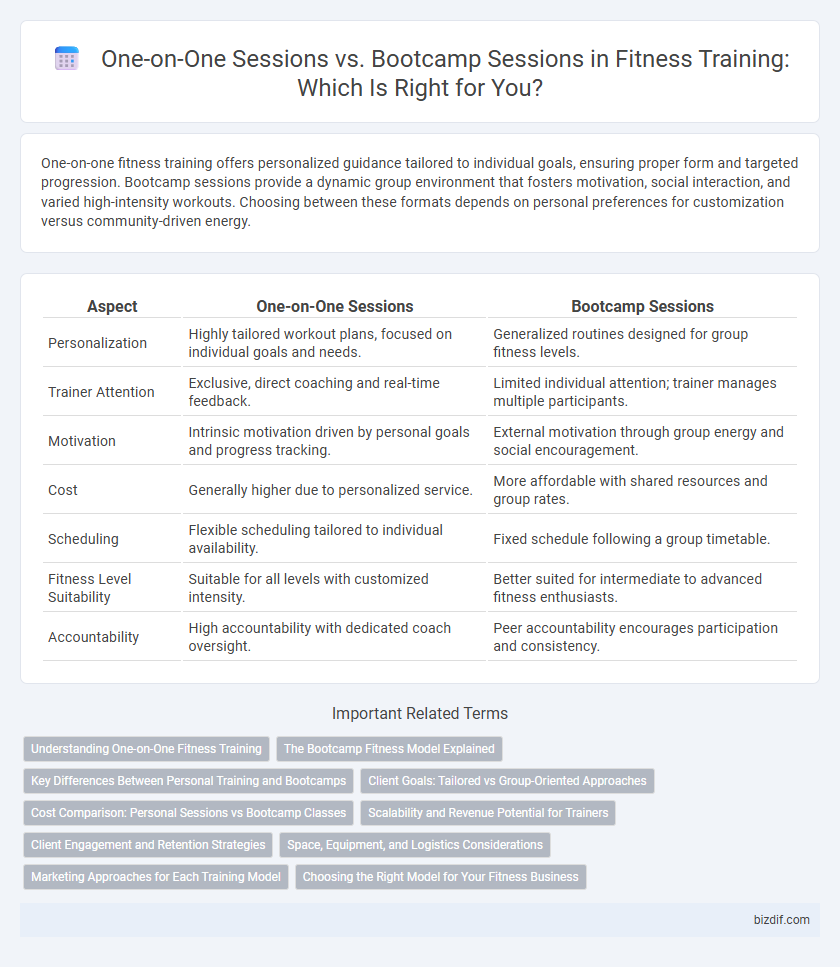One-on-one fitness training offers personalized guidance tailored to individual goals, ensuring proper form and targeted progression. Bootcamp sessions provide a dynamic group environment that fosters motivation, social interaction, and varied high-intensity workouts. Choosing between these formats depends on personal preferences for customization versus community-driven energy.
Table of Comparison
| Aspect | One-on-One Sessions | Bootcamp Sessions |
|---|---|---|
| Personalization | Highly tailored workout plans, focused on individual goals and needs. | Generalized routines designed for group fitness levels. |
| Trainer Attention | Exclusive, direct coaching and real-time feedback. | Limited individual attention; trainer manages multiple participants. |
| Motivation | Intrinsic motivation driven by personal goals and progress tracking. | External motivation through group energy and social encouragement. |
| Cost | Generally higher due to personalized service. | More affordable with shared resources and group rates. |
| Scheduling | Flexible scheduling tailored to individual availability. | Fixed schedule following a group timetable. |
| Fitness Level Suitability | Suitable for all levels with customized intensity. | Better suited for intermediate to advanced fitness enthusiasts. |
| Accountability | High accountability with dedicated coach oversight. | Peer accountability encourages participation and consistency. |
Understanding One-on-One Fitness Training
One-on-one fitness training offers personalized workout plans tailored to individual goals, fitness levels, and health conditions, ensuring targeted progress and injury prevention. Trainers provide immediate feedback, adjust techniques in real-time, and motivate clients to reach their maximum potential efficiently. This customized approach contrasts with bootcamp sessions, which emphasize group dynamics and general fitness improvements across diverse participants.
The Bootcamp Fitness Model Explained
Bootcamp fitness sessions combine high-intensity interval training with group dynamics, promoting motivation and camaraderie while engaging multiple muscle groups through varied exercises. These classes typically last 45 to 60 minutes and emphasize functional movements that improve cardiovascular endurance, strength, and flexibility. Compared to one-on-one training, bootcamp classes offer a cost-effective solution that fosters community support and competitive spirit, enhancing overall workout adherence and results.
Key Differences Between Personal Training and Bootcamps
Personal training offers individualized workout plans tailored to specific fitness goals, allowing close supervision and immediate feedback from the trainer. Bootcamp sessions emphasize group dynamics, high-intensity interval training (HIIT), and motivational support within a community setting. The key differences lie in customization, trainer-to-client ratio, and the balance between personalized guidance and social engagement.
Client Goals: Tailored vs Group-Oriented Approaches
One-on-one fitness training offers a tailored approach that specifically addresses individual client goals, allowing for personalized exercise plans, technique adjustments, and progress tracking. Bootcamp sessions emphasize group-oriented dynamics, motivating participants through collective energy and camaraderie while following a generalized workout structure. Choosing between these depends on whether clients prioritize customization and individualized attention or prefer a social, high-energy environment to boost motivation.
Cost Comparison: Personal Sessions vs Bootcamp Classes
One-on-one fitness sessions typically cost between $50 and $100 per hour, offering personalized attention and tailored workouts that maximize individual progress. Bootcamp classes, averaging $10 to $25 per session, provide a more affordable group environment but with less individualized guidance. Choosing between personal sessions and bootcamp classes depends on budget considerations and the desired level of customization in training.
Scalability and Revenue Potential for Trainers
One-on-one fitness sessions offer personalized training that can command higher rates, but scalability is limited by the trainer's available hours. Bootcamp sessions allow trainers to maximize revenue by training multiple clients simultaneously, increasing efficiency and profit margins. Leveraging group dynamics in bootcamps drives client retention and expands scalability beyond one-on-one constraints.
Client Engagement and Retention Strategies
One-on-one fitness sessions provide personalized coaching that fosters stronger client engagement through tailored workout plans and direct feedback, leading to higher retention rates. Bootcamp sessions leverage group dynamics and social motivation to keep clients accountable and energized, enhancing long-term commitment through community support. Combining individualized attention with group energy can optimize client retention by addressing diverse motivational needs.
Space, Equipment, and Logistics Considerations
One-on-one fitness training sessions require dedicated space and personalized equipment setup tailored to individual goals, allowing greater control over exercise selection and intensity. Bootcamp sessions necessitate larger, open spaces to accommodate multiple participants simultaneously and often utilize versatile, portable equipment like mats, resistance bands, and bodyweight stations. Effective logistics planning for bootcamp includes scheduling, participant flow management, and equipment sanitization to ensure safety and maximize efficiency.
Marketing Approaches for Each Training Model
One-on-one fitness training marketing emphasizes personalized results, targeting clients seeking customized workout plans and individual attention through platforms like social media testimonials and tailored email campaigns. Bootcamp session marketing highlights group energy and community support, leveraging local event promotions, group discounts, and social proof to attract fitness enthusiasts motivated by camaraderie and accountability. Effective strategies use data-driven insights to segment audiences, optimizing ad spend for personalized training or high-intensity group workouts, maximizing client acquisition and retention.
Choosing the Right Model for Your Fitness Business
One-on-one sessions offer personalized coaching tailored to individual goals, maximizing client progress through customized workout plans and direct feedback. Bootcamp sessions provide a group dynamic that fosters motivation and camaraderie, making it easier to scale and increase revenue per session. Selecting the right model depends on your target market, available resources, and business goals to effectively balance client engagement with profitability.
One-on-one sessions vs Bootcamp sessions Infographic

 bizdif.com
bizdif.com